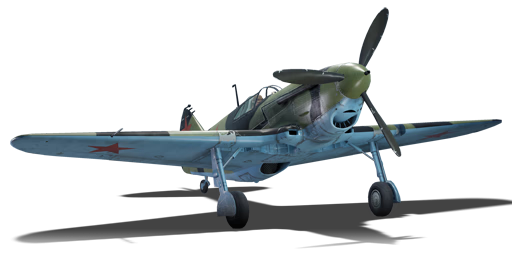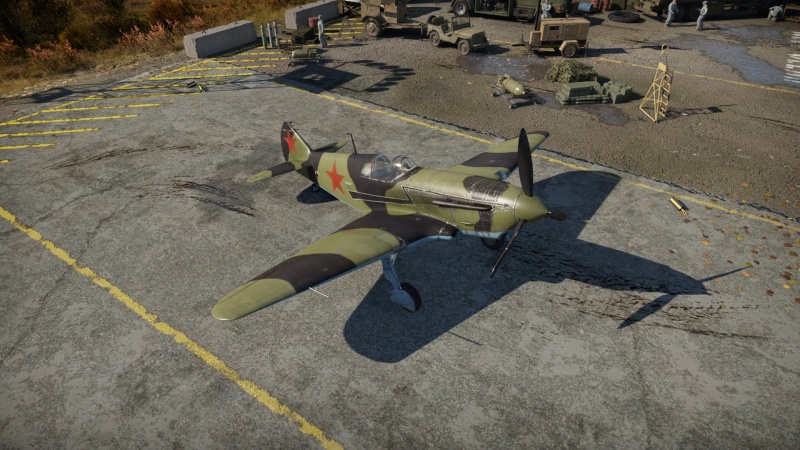Difference between revisions of "LaGG-3-11"
m (→Flight performance: AB and RB stock speed) (Tag: Visual edit) |
m (→Survivability and armour: Added bullet point list of plane's armour) (Tag: Visual edit) |
||
| Line 100: | Line 100: | ||
=== Survivability and armour === | === Survivability and armour === | ||
{{Specs-Avia-Armour}} | {{Specs-Avia-Armour}} | ||
| − | ' | + | |
| + | * 8 mm Steel - Pilot's seat back | ||
| + | * Self-sealing fuel tanks | ||
=== Modifications and economy === | === Modifications and economy === | ||
Latest revision as of 21:09, 2 September 2024
| This page is about the Soviet fighter LaGG-3-11. For other versions, see LaGG-3 (Family). |
Contents
Description
The LaGG-3-11 is a rank II Soviet fighter with a battle rating of 2.3 (AB/SB) and 2.0 (RB). This aircraft was introduced in Update 1.33.
General info
Like the other LaGG-3 models, the 3-11 has the advantage of an extremely low BR and cannon armament. The top speed is comparatively high when put against planes such as the P-36G or Ki-43-II. The climb rate is also quite good, attributed to the high max speed and acceleration. However, the turn rate and elevator are extremely poor. Energy fighting is a must when it comes to the LaGG-3.
Since the LaGG-3 has cannon armament, a 2-4 second burst is all that is needed to shred an enemy plane. Use Ground Target belts for the best effect with both the ShVAK and Berezin UB.
Flight performance
| Characteristics | Max Speed (km/h at 5,000 m) |
Max altitude (metres) |
Turn time (seconds) |
Rate of climb (metres/second) |
Take-off run (metres) | |||
|---|---|---|---|---|---|---|---|---|
| AB | RB | AB | RB | AB | RB | |||
| Stock | 539 | 521 | 9000 | 25.2 | 26.2 | 7.7 | 7.7 | 400 |
| Upgraded | 584 | 561 | 22.8 | 24.0 | 14.1 | 10.6 | ||
Details
| Features | ||||
|---|---|---|---|---|
| Combat flaps | Take-off flaps | Landing flaps | Air brakes | Arrestor gear |
| ✓ | ✓ | ✓ | X | X |
| Limits | ||||||
|---|---|---|---|---|---|---|
| Wings (km/h) | Gear (km/h) | Flaps (km/h) | Max Static G | |||
| Combat | Take-off | Landing | + | - | ||
| 0 | 350 | 440 | 414 | 280 | ~12 | ~9 |
| Optimal velocities (km/h) | |||
|---|---|---|---|
| Ailerons | Rudder | Elevators | Radiator |
| < 380 | < 380 | < 380 | > 323 |
| Compressor (RB/SB) | ||
|---|---|---|
| Setting 1 | ||
| Optimal altitude | 100% Engine power | WEP Engine power |
| 2,000 m | 1,100 hp | 1,232 hp |
| Setting 2 | ||
| Optimal altitude | 100% Engine power | WEP Engine power |
| 4,000 m | 1,050 hp | N/A |
Survivability and armour
- 8 mm Steel - Pilot's seat back
- Self-sealing fuel tanks
Modifications and economy
Armaments
Offensive armament
The LaGG-3-11 is armed with:
- 1 x 20 mm ShVAK cannon, nose-mounted (150 rpg)
- 1 x 12.7 mm Berezin UB machine gun, nose-mounted (200 rpg)
Suspended armament
The LaGG-3-11 can be outfitted with the following ordnance:
- Without load
- 2 x 50 kg FAB-50 bombs (100 kg total)
- 2 x 100 kg FAB-100 bombs (200 kg total)
- 6 x RS-82 rockets
- 6 x RBS-82 rockets
Usage in battles
The LaGG-3-11 is best use as a multirole fighter with a good climb rate, making boom and zoom a viable tactic, but turn fighting can help when facing less nimble aircraft. The armaments are nose mounted and fewer in number than most counterparts, making this plane less beginner friendly. Accuracy and trigger discipline are more important as there won't be much rounds when pulling the trigger, but when the rounds hit, it deals effective damage.
In ground realistic battles, the FAB-100 bombs are a good choice to take out tanks and should be prioritized over rockets. At this plane's BR, the bombs will be more than enough to take out a tank or two. Using the vehicle's climb speed after bombing is preferable to scout the battlefield for unsuspecting aircraft. Boom and zoom is the best tactic to catch most aircraft off guard.
Manual Engine Control
| MEC elements | ||||||
|---|---|---|---|---|---|---|
| Mixer | Pitch | Radiator | Supercharger | Turbocharger | ||
| Oil | Water | Type | ||||
| Controllable | Controllable Not auto controlled |
Controllable Auto control available |
Controllable Auto control available |
Separate | Controllable 2 gears |
Not controllable |
Pros and cons
Pros:
- Cannon
- Effective Berezin UB MG
- Speed and climb rate
- Durability
- Substantial ammunition supply
Cons:
- Poor handling at high speeds
- Average horizontal handling, poor vertical handling
- Low ammo count with Berezin UB MG
- Poor roll rate
- Wings tend to snap when turning against biplanes
History
The LaGG-3-11 was a Soviet fighter aircraft of World War II. It was one of the most modern aircraft available to the Soviet Air Force at the time of Germany's invasion in 1941. The plane was produced 1941–1944 and first took flight 28 March 1940. Approximately 6,528 LaGG-3-11's were made, and designed by V. P. Gorbunov.
| Archive of the in-game description | |
|---|---|
|
As a result of further work on transforming the LaGG from a "pure" fighter into a light attack aircraft, the LaGG 3 Series 11 appeared at the turn of 1941–1942. It had missile equipment and DZ-40 bomb racks for two bombs weighing up to 100 kg. To reduce the plane's weight and finally increase its flight characteristics to acceptable levels, the series 11 completely lacked outboard fuel tanks, sacrificing flight range for speed. Suspended fuel tanks were intended for use when necessary, but in practice, they were only installed on a small batch of fighters made for the navy. The following bombs could be suspended on the DZ-40 bomb racks underneath the wing: FAB-50 and FAB-100 general-purpose bombs, AO-25 fragmenting bombs and VAP-6M aerial spray instruments. These bomb racks could also carry ZAP-6 incendiary aerial instruments containing 38 liters of incendiary fuel each, or PSB-100 suspended fuel tanks containing up to 100 liters of gasoline. RO-82 launchers for RS-82 rockets were also installed under the wing. The standard design allowed for the installation of six RO-82 launchers. Combat units armed the LaGG-3 with rockets themselves, so the number of rockets varied between four to eight RS-82 rockets. Several planes were equipped with RO-132 rocket launchers instead of the RO-82, in order to launch the more powerful RS-132 rockets. The LaGG-3 Series 11 went into production at the end of 1941. The first LaGG-3 Series 11 fighter-bombers took part in combat in the final stage of the Battle of Moscow, on the Kalinin front. Use of the LaGG-3 as a fighter-bomber and attack aircraft was relatively successful, as the LaGG-3 planes demonstrated higher combat survivability than other types of fighters. Later on, the LaGG-3 Series 11 was replaced by the Series 23 in manufacturing facilities. The Series 23 was practically identical to the Series 11 and had the same combat characteristics. Their production continued from the end of the winter of 1942 to the summer of 1942 and was the peak period of LaGG-3 fighter manufacturing in terms of quantity. | |
Media
- Skins
See also
Links to the articles on the War Thunder Wiki that you think will be useful for the reader, for example:
- reference to the series of the aircraft;
- links to approximate analogues of other nations and research trees.
External links
| Lavochkin Design Bureau (Лавочкинa Опытное конструкторское бюро) | |
|---|---|
| LaGG-3* | I-301 · LaGG-3-4 · LaGG-3-8 · LaGG-3-11 · LaGG-3-23 · LaGG-3-34 · LaGG-3-35 · LaGG-3-66 |
| La-5/7 | La-5 · La-5F · La-5FN · La-7 · Dolgushin's La-7 · La-7B-20 |
| La-9/11 | La-9 · La-11 |
| Jet Fighters | La-15 · La-174 · La-200 |
| Export | ␗La-9 · ␗La-11 |
| Captured | ▀La-5FN |
| *Lavochkin-Gorbunov-Gudkov (Лавочкин-Горбунов-Гудков), head designer V. P. Gorbunov | |
| USSR fighters | |
|---|---|
| I-15 | I-15 WR · I-15 M-22 · I-15 M-25 · I-15bis · Krasnolutsky's I-15bis |
| I-153 M-62 · Zhukovsky's I-153-M62 · I-153P | |
| I-16 | I-16 type 5 · I-16 type 10 · I-16 type 18 · I-16 type 24 · I-16 type 27 · I-16 type 28 · I-180S |
| I-29 | I-29 |
| I-185 | I-185 (M-71) · I-185 (M-82) |
| I-225 | I-225 |
| ITP | ITP (M-1) |
| MiG-3 | MiG-3-15 · MiG-3-15 (BK) · MiG-3-34 |
| LaGG | I-301 · LaGG-3-4 · LaGG-3-8 · LaGG-3-11 · LaGG-3-23 · LaGG-3-34 · LaGG-3-35 · LaGG-3-66 |
| La | La-5 · La-5F · La-5FN · La-7 · Dolgushin's La-7 · La-7B-20 · La-9 · La-11 |
| Yak-1/7 | Yak-1 · Yak-1B · Yak-7B |
| Yak-3 | Yak-3 · Eremin's Yak-3(e) · Yak-3P · Yak-3T · Yak-3U · Yak-3 (VK-107) |
| Yak-9 | Yak-9 · Yak-9B · Golovachev's Yak-9M · Yak-9T · Yak-9K · Yak-9U · Yak-9UT · Yak-9P |
| Other countries | ▂P-40E-1 · ▂P-47D-27 · ▂Hurricane Mk IIB · ▂Fw 190 D-9 · ▂Spitfire Mk IXc |
| P-39 | ▂P-39K-1 · ▂Pokryshkin's P-39N-0 · ▂P-39Q-15 |
| P-63 | ▂P-63A-5 · ▂P-63A-10 · ▂P-63C-5 |





